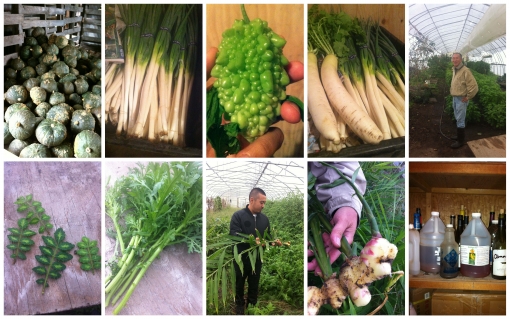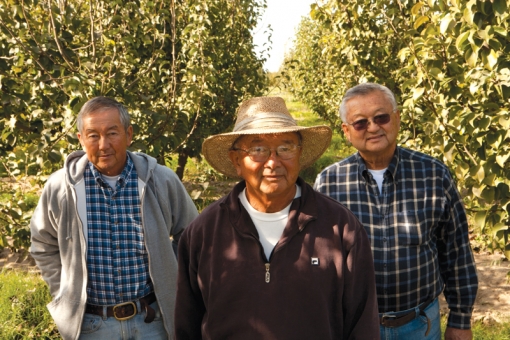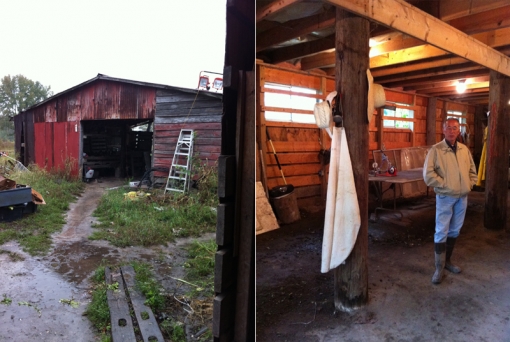
Kaye Kozuki is passionate about peaches. She’s a peach partisan. “My favorites are the low-acid nectarines,” she says. “Most stores don’t write down the variety, or let you know what type of fruit you’re eating, but we do. It matters.”
Kozuki’s family has owned their stone fruit and grape farm in Parlier, CA for almost 100 years. Begun in 1926, it is now farmed by three of George and Hisaye Kozuki’s eight children, all third-generation Japanese Americans. The Kozuki parcel is 850 acres spread around the town of Parlier, about 30 miles south of Fresno in California’s Central Valley, the heart of the state’s booming fruit and vegetable industry. California farmers supplied almost half of the nation’s fresh vegetables and 68 percent of processed vegetables in 2008, according to the California Department of Food and Agriculture.
Farming is an unpredictable and financially nerve-wracking enterprise. Margins are low, and product must be sold in narrow windows of time, leaving farmers are the mercy of the markets.
The Kozukis, however, are part of a small but growing group of Asian American farmers determined to overcome the odds: They’re reaching directly to consumers using a strategy called “direct-to-consumer marketing.” This means selling their products at farm stands, farmers markets, and through mailorder and box subscription. The practice differs from selling to a wholesaler who distributes in bulk to supermarkets, restaurants and food-service companies. The decentralization means higher profits to farmers — if they’re looped into those channels.
The US Department of Agriculture takes a national survey every five years of farming and farm sales, and their most recent findings in 2007 found direct-to-consumer sales totaling about $1.2 billion. Within vegetables and melons alone, direct-to-consumer recorded a stunning 97 percent increase in sales in 13 years, reaching $335 million by 2007. The growth in direct-to-consumer sales (mostly of fruits and vegetables, but increasingly among meat, eggs, and other products) can be traced to many factors, including the popularity of farmers markets and increased interest among consumers in the source of their food.
While almost all of the Kozuki family’s fruit is sent to a local packer (who ships to supermarkets and Wal-Marts around the world), about a half percent is taken to Fresno’s Vineyard Farmers Market. There, Kaye Kozuki sells what she calls “the best of the best” to shoppers willing to come out rain or shine and pull from her boxes of white peaches, yellow peaches, nectarines, pears, and a few plums and grapes. Her prices are comparable to that at the local grocery, with the difference being that family farm takes home three to five times more profit.
Coming to the farmers market, while it reflects only a small part of their business, allows the Kozukis to hear what their customers want and to shape their product mix accordingly. Kozuki is adamant about having an actual farmer at the stand to ensure accountability and get feedback from consumers. “Over the years, we have become friends with our customers and educated them about our fruits,” she says.
One thing non-farmers can learn about, for example, is the ripening process. If a piece of fruit is picked too early, it can be hard, green or tasteless. Picked too late, it may look camera-ready but can spoil in one hot day at the market. Farmers like the Kozukis carefully calibrate how long to leave fruit on the vine or the tree in order to preserve flavor while preventing rot.
“Customers want it ready to eat, but I lose too much fruit that way. You have to take care of it,” Kozuki says to customers increasingly accustomed to pre-cut and ready-to-eat items. “You have to let them sit out a couple days [before eating].” Customers also quibble about appearance, misshapes and pockmarks. Because the Kozukis’ farm limits use of pesticides, however, the perfect-looking pink orb of a peach is rarely possible.
In a way, farmers are the first entrepreneurs. They are their own bosses with at times crushing responsibility;they have wide latitude to create what they want but a set window in which to sell it. They’re risk-takers to the extreme, and for Asian American farmers, discrimination, language barriers and alienation sometimes make it even harder. At the same time, Asian American farmers stand to benefit from increased awareness and popularity of Asian vegetables and fruits.
Ken Suzuki is a Delmar, DE vegetable farmer who sells almost exclusively to Japanese restaurants and groceries. About 10 percent of his crop is sold direct-to-consumer, via mail order and at the occasional farm stand at a cultural fair or church bazaar. He considers his company, called Nihon Yasai (or “Japanese Vegetables”), a cultural bridge and a taste of home for his mostly expat customers; he has little contact with non-Japanese customers or farmers. “That’s why I grow – it’s for them. If they were not happy with me, I’d quit,” he says with an ominous hand-slice across his neck. “It’s very hard, but my English is not so good so I must do something.”
The greenhouses and neat fields of his 58-acre farm are packed with over 30 varieties of Japanese vegetables: shishito, shiso, daikon, yuzu, Japanese cucumber, eggplant, squash, green onion and cabbage. When Suzuki started 28 years ago, no one grew many of these vegetables on the Eastern seaboard. He endured tough years renting farmland and experimenting with the differing soils and conditions of Maryland and Delaware. For health and cost-cutting reasons, Suzuki made homemade pesticides by brewing hot peppers and extracting the juice of garlic chives, then spraying a diluted mixture over the fields. Little by little, he found stability in his crops and his business model. He is still recovering from a $200,000 loss during the 2005-06 growing season, when prices dropped, plants died, and he had to move from his leased land.
On the drizzly Sunday afternoon I visited, we walked through a creaky plastic door that led to greenhouses packed with vegetables in the Japanese style of space-conserving agriculture: tightly-hewn rows between small citrus trees and cherry tomato vines trained onto chest-high poles four-deep. Another greenhouse teems with small flats of sprouts sharing space with young ginger stalks. One greenhouse of cucumbers suffered a double-whammy of disease and fungus this year, and when we opened its door white mist covered the wilted leaves of a cucumber graveyard: The entire crop had been lost. Although government programs can provide insurance for setbacks like cucumber fungus, Suzuki says he didn’t feel confident enough in his English the few times he attended those meetings.
Sales on Suzuki’s online site Nihonyasai.com, aren’t easy either, because unlike in his native Japan, there’s no chilled delivery service for residential produce shipments, and customers sometimes complain of vegetables arriving too hot or too cold. They continue to order, however, as do restaurants who are both appreciative of his unique selection and demanding of newer and more obscure varieties. Yuzu was trendy last year, shishito may be next. Suzuki is the one who must quickly respond and pray that land, heat, water and insects cooperate.
While a few high-profile farmers markets sell expensive gourmet items, Suzuki pushes back against the perception that direct-to-consumer is more expensive. “I make sure to price close to the supermarket. I just get more than when I sell to a wholesaler,” he says. However, in the instances when his prices can’t compete with those from the West Coast, where the growing season is longer and transportation costs are lower, Suzuki tries to explain to his East Coast customers why his Delaware vegetables might cost a little more: “They know how much I take care of the plants. In a big farm, it’s all done by machines, and they don’t really take care of the plants until harvest.”
Whereas Suzuki sells about 10 percent of his product directly to consumers, the Lees of Peconic, NY sell their entire crop retail, bypassing supermarkets altogether. Sang Lee Farms (motto: “Our Produce is Fresh-Lee-Cut!”) benefits from the popularity of direct-to-consumer sales in New England, a region where this business model forms a higher share of total agricultural sales than in other parts of the country. After decades in the wholesale business, the Lees switched to their current combination of farmers markets and a roadside farm stand. They also participate in community-supported agriculture, a group investment scheme that began in Japan in the 1960s.
Community-supported agriculture, or CSAs, didn’t start with food: News reports of toxic chemicals in liquid soap led housewives to seek out all-natural soap for washing diapers and other household uses. When only industrial quantities could be found, the women organized groups in their neighborhoods to split the purchases. This DIY sourcing expanded to include vegetables, rice and other staples. Today, the largest CSAs in Japan distribute glossy catalogues with photos of farmers to millions of households across the country, while smaller corner operations continue to buy and share in bulk much like they did over 30 years ago.
In the United States, CSAs are undertaken more for the relationships they create and the financial security they bring to farmers. Members pay a sum at the beginning of each season to help a farmer buy seeds, fertilizers and other necessities. In return, they get a box of assorted produce throughout the season, usually topped off by a farm tour or other educational events organized by the farmer. Tucked inside the boxes (or sent by email) are newsletters describing life on the farm, including setbacks like bug attacks or a late-season rain. The “community” aspect of a CSA expands commercial transactions into the idea that eater and producer share the largesse or the disaster that Mother Nature can bring. While CSAs are not as popular in this country as in other parts of the world, the 2007 Census of Agriculture lists 12,549 CSAs across the United States. Specific data does not yet exist on Asian American adoption of this direct-to-consumer sales model (although Asian Americans are entering farming at much higher rates than the general population).
The Lee family learned about CSAs with the help of Just Food, a nonprofit in New York City that acts as a matchmaker between interested pockets of urban residents and smaller farms that want to sell directly to consumers but don’t know how. The Lees now bring boxes of pre-sold veggies every week to their three Brooklyn CSAs, including one in DUMBO (short for “Down Under Manhattan Bridge Overpass”), about as far from the farm as one can get.
Fred Lee is the co-owner of Sang Lee Farms and a second-generation farmer. His father and uncles supplied bok choy and other Chinese vegetable staples from their farm on Long Island, NY and later from a winter farm in Hobe Sound, FL. They sold to restaurants and Chinese markets along the East Coast and as far away as Montreal. Fred didn’t think he’d get into farming until his father suddenly grew ill at the beginning of one planting season.
Fred was 26 and brought home his then-girlfriend Karen (they met at Boston University business school), plunged into the family business, marrying and raising three children between the two farms. With Karen’s help, the farm grew, moved and expanded its non-Asian vegetable offerings and started selling packaged products like salad dressing, pesto and jellies. At 56, they are both slim and full of energy.
In the 1990s, Karen started doing cooking demonstrations at their farmstand on Saturdays, teaching people how to use vegetables like gai lan, yu choi, Shanghai and mustard greens. “I could tell they were intimidated by a big bag of Asian vegetables, so I cut them smaller and put them in a bag with onions and the necessary sauces, and called it a stir-fry combo pack,” says Karen, a petite Boston native with a warm smile.
I asked her what the Chinese American community’s reaction was to this new method of selling and using traditional vegetables. “They thought I was crazy!” she laughs. Non-Asian customers, however, snapped up the knowledge and the stir-fry bags — and their farm survived that downturn.
Over the course of a decade, their farm transitioned completely from wholesale to retail, and the Lees emphasize the twists and turns their business endured through the years. The late ’90s were the hardest for them, when cheap agricultural imports from Mexico and Canada flooded in following the passage of NAFTA. “If people only knew how much hard work it takes, they would have greater respect and appreciation,” says Karen as she deftly maneuvers her golf cart around the Long Island farm, where they have consolidated their operations. “One crop takes three years, so it takes patience.” We pass asparagus and strawberry plants in various stages of growth, regeneration or cleanup, reflecting the complicated calendar every farmer must plan for.
For every customer who insists on a lower price (I’m guilty as charged), there’s a farmer who wants to explain what their prices mean. Increasingly, many are choosing direct-to-consumer sales to inform their customers about the realities of farming. Fred Lee is grateful for recent successes but hopes consumers won’t forget the effort that went into their lettuce and tomatoes: “If you think my food is too expensive, try to grow your own food. Plant a seed and see what happens. After feeding yourself, try to pay your bills based on growing that food. It’s not easy.”
He remains optimistic, however, even encouraging young people to join him in the business. “I think to grow your own food, and to produce something almost from nothing, is great. That’s one of the rewards that I continue to have with the farm. We eat all the produce that we grow, and I’m just tickled by that. I love the freshness, I love that it’s organic, and it helps us be healthy, you know?” he says as the store closes up and the sun starts to fall behind the trees bordering his farm. “It’s a constant education process with the people we sell to, and I still have so much more to learn myself.”
Nina Kahori Fallenbaum is Hyphen’s food editor. She last wrote about restaurant-worker organizer Bonnie Kwon.

Kozuki Farms (Photo by John Alden, JA Photography)

Suzuki Farm (Photos by Kenshin Ichikawa)









Comments